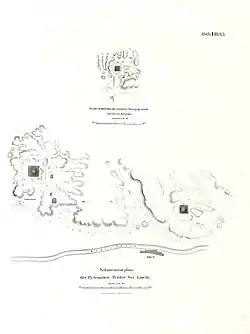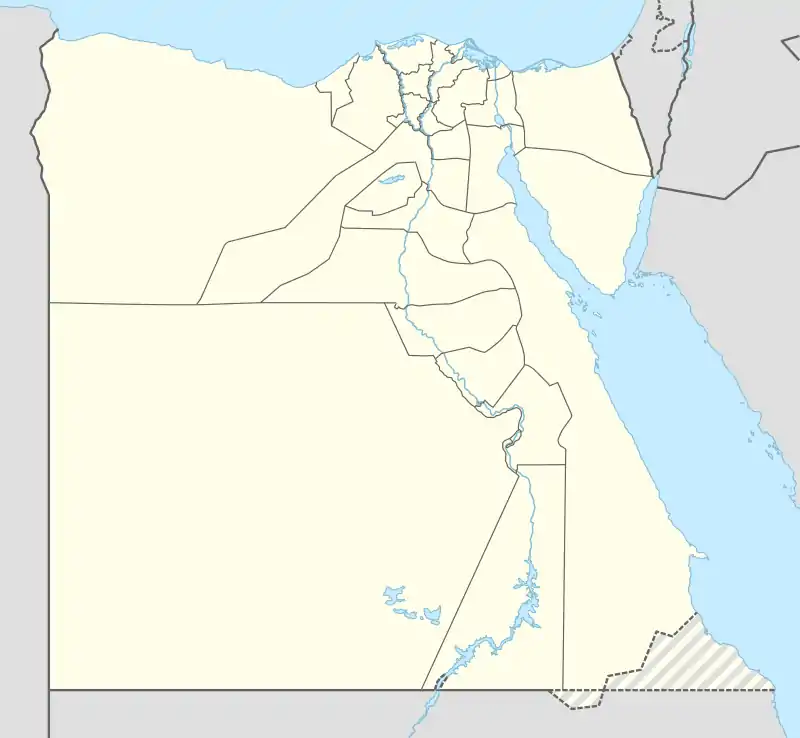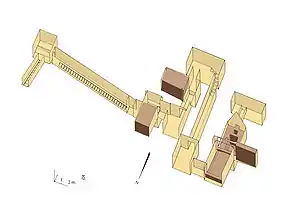| Northern Mazghuna pyramid | |
|---|---|
 | |
| Sobekneferu(?), 12th Dynasty(?) | |
| Coordinates | 29°46′3″N 31°13′15″E / 29.76750°N 31.22083°E |
| Ancient name | Mazghuna |
| Constructed | 12th or 13th Dynasty |
| Type | True pyramid |
| Base | 52.5 m (172 ft) |
 Architectural structure of the Northern Mazghuna pyramid | |
The Northern Mazghuna Pyramid is an ancient Egyptian royal tomb which was built during the 12th or 13th Dynasty in Mazghuna, 5 km south of Dahshur. The building remained unfinished, and it is still unknown which pharaoh was really intended to be buried here since no appropriate inscription has been found.
The pyramid was rediscovered in 1910 by Ernest Mackay and excavated in the following year by Flinders Petrie.[1]
Attribution
When the two Mazghuna pyramids were rediscovered, scholars noticed many structural similarities between those two and Amenemhat III's pyramid at Hawara; for this reason the southern pyramid was attributed to the son and successor of this king, Amenemhat IV. Subsequently, the northern pyramid was attributed to the female-pharaoh Sobekneferu, sister of Amenemhat IV and last ruler of the 12th Dynasty.
However, some scholars such as William C. Hayes[2] believed that the two Mazghuna pyramids were built during the 13th Dynasty, on the basis of some similarities with the pyramid of Khendjer. In this case, the northern pyramid should have belonged to one of the many pharaohs who ruled between the beginning of the 13th Dynasty and the loss of control of the northern territory occurred during or after the reign of Merneferre Ay.[3]
Description
The pyramid superstructure seem to have never been started, and the only information that can be determined from it is that the pyramid was planned larger than its southern neighbor, which has a side length of 52.5 m (172 ft).

The hypogeum is similar to the one of the southern pyramid but much more tortuous, changing direction six times. The entrance is on the north side. From there, a staircase leads down to a square chamber and then to another staircase and to the first quartzite blocking. After that, two other chambers are connected by a passage with a second, still unsealed blocking. After the third chamber, a stairway and then a corridor leads to the antechamber just prior to the large burial chamber: this room, partially covered by an inverted V-shaped ceiling, is entirely filled by a huge sarcophagus-vault, which was carved from a single block of quartzite. The never-used sarcophagus lid, a 42-ton quartzite slab, still awaits to be fitted in the chamber. All exposed quartzite, which was built in the pyramid, had been painted with red paint and sometimes also decorated with vertical black stripes. The function of a large room behind the burial chamber remain unknown.[4][5]
From the pyramid complex, the valley temple, the funerary temple and the enclosure walls had apparently left no traces. Only a large portion of the causeway has been discovered, as well as another blocking stone, likely abandoned due to a change of the pyramid's design.
See also
References
- ↑ Flinders Petrie, G. A. Wainwright, E. Mackay: The Labyrinth, Gerzeh and Mazghuneh, London 1912, available online.
- ↑ W.C. Hayes, The Scepter of Egypt. A Background for the Study of American Antiquites in the Metropolitan Museum of Art. From the Earliest times to the End of the Middle Kingdom, New York, 1953.
- ↑ McCormack, Dawn. "The Significance of Royal Funerary Architecture in the Study of 13th Dynasty Kingship." In M. Marée (ed) The Second Intermediate Period (13th-17th Dynasties), Current Research, Future Prospects, Belgium: Peeters Leuven, 2010, pp. 69-84.
- ↑ Franco Cimmino, Storia delle Piramidi. Rusconi, Milano 1996, pp. 294–295, ISBN 88-18-70143-6.
- ↑ Mark Lehner, The Complete Pyramids, Thames and Hudson, London 1997, pp. 184-185. ISBN 0-500-05084-8.
- Rainer Stadelmann, Die ägyptischen Pyramiden. Vom Ziegelbau zum Weltwunder. Verlag Philipp von Zabern, 3. Aufl., Mainz 1997, p. 251, ISBN 3-8053-1142-7
- Miroslav Verner, Die Pyramiden. Rowohlt Verlag, Reinbek 1998, pp. 472–474, ISBN 3-499-60890-1.